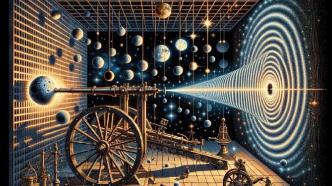
[Editor's note] The academic circle has not yet reached a consensus on the interpretation of quantum mechanics, and there is a philosophical opposition between "monism" and "dualism". Academician Sun Changpu, dean of the Graduate School of the China Academy of Engineering Physics and a professor of the School of Physics at Peking University, believes that it is advisable to follow the value of "the avenue to simplicity", that is, if two theories can make equally accurate predictions about the same problem, then one should choose Use the one with the fewest assumptions.
Sun Changpu also demonstrated from the perspective of philosophy of science that falsifiability and Occam's razor can be the basis for quantum interpretation, which also embodies the beauty of the logic of quantum mechanics.
Furthermore, Sun Changpu criticized the inverse Occam's razor phenomenon in the current scientific research community - when there are two competing theories, the theory that provides a more fancy explanation for the experimental data takes precedence, and this also creates a gray area in the academic field. He called for a profound understanding of these issues from a philosophical perspective, and for scientific research practice to return to the scientific practice of discovering truth.
Quantum mechanics is undoubtedly one of the most successful theories in the history of science. However, there is still no consensus on the interpretation of quantum mechanics. In essence, there is a philosophical opposition between "monism" and "dualism".
The Copenhagen School, represented by Bohr, insists that quantum mechanics cannot avoid the interpretation of dualism: the description of the wave function of quantum mechanics must rely on classical elements—observation leads to the irreversible collapse of the wave packet, and the relevant measuring instruments and observers can only obey classical physics. . The wave packet collapse with dualistic properties is a non-unitary evolutionary process, which is inconsistent with the unitary evolutionary process described by the Schrödinger equation.
Different from Einstein's new angle of questioning quantum mechanics, many famous theoretical physicists such as Schrödinger and Weinberg have criticized the "philosophy of dualism" again and again, and at the same time formed the principles of quantum mechanics such as "many worlds" and quantum decoherence. Monistic Interpretation: Explaining the results of quantum mechanical measurements by describing instruments and observers within the framework of quantum mechanics itself without resorting to classical physics.
However, based on the final observation results alone, it is usually impossible to decide which theory is correct, and the theory usually does not have the uniqueness of explanation. There are monistic and dualist interpretations of quantum mechanics, but their theoretical predictions about the outcome of measurements are often ideally consistent, so it is impossible to distinguish which of these interpretations is better.
This is the same as the dispute between the "geocentric theory" and Copernicus' "heliocentric theory": the former can basically explain Tycho's observation of astronomical phenomena as long as the very complicated "epicycle-deferent" is added, and the latter replaces the perfect circular orbit with an ellipse As a result (strictly speaking, planetary apparent motion has two kinds of irregularities, speed and retrograde, and the heliocentric theory without a uniform wheel can only explain the latter). That is, in the sense of a "single-shot" experiment alone, one cannot tell which of the quantum-mechanical interpretations is better, monism or dualism, because within the framework of these interpretations one can only predict the same observations.
Interpretation and Falsifiability of Quantum Mechanics
The simplicity of the "heliocentric theory" based on the elliptical orbit wins over the cumbersomeness of many "epicycle-deferent" and "geocentric theory". Not only that, the "heliocentric theory" gives more predictions with fewer parameters, and thus gives more opportunities to be verified. In this sense, this is the philosophical Occam's razor effect.
However, from the perspective of philosophy of science, we can still distinguish between monism and dualism interpreted by quantum mechanics, which is more scientific. We just need to follow the value of "the best is the simplest": if two theories about the same problem can make equally accurate predictions, then the one with the fewest assumptions should be chosen.
Although the more complex the method is, the better the prediction can be made, but it is necessary to balance the relationship between the number of assumptions and the size of the prediction ability. Only when the number of predicted results shows a non-linear increase relative to the number of theoretical assumptions, can we say that this is a really good theory, just as the simple victory of the "heliocentric theory" based on elliptical orbits is based on many "epicycle-definition" and "geocentric theories" "The cumbersome. Not only that, the "heliocentric theory" gives more predictions with fewer parameters, and thus gives more opportunities to be verified. In this sense, this is the philosophical Occam's razor effect.
In the debate on the interpretation of quantum mechanics, the theory of quantum measurement based on quantum decoherence belongs to the category of monism. It does not introduce any additional assumptions, but only regards the measurement process as the interaction between a quantum system with few degrees of freedom (the system to be measured) and a quantum system with many degrees of freedom (instrument or observer), the overall large system and the two All of them obey the Schrödinger equation. This description is monistic, it can give the relationship of the measurement results to the interaction (measurement) time dependence, and there are more theoretical predictions than dualism that can be compared and verified. Therefore, many people think that the interpretation of the monism of quantum mechanics is "better" than the interpretation of the Copenhagen School.
It should be pointed out that these specific analyzes of the interpretation of quantum mechanics imply falsifiability, which is the philosophical and logical basis of Occam's razor effect. Falsifiability refers to the possibility that conclusions derived from a theory—theoretical predictions—can contradict or contradict observational statements in logical principle. The founder of the theory, the philosopher Karl Popper, believes that "all scientific propositions must be falsifiable, and unfalsifiable theories cannot become scientific theories."
In fact, there is an implicit definition of pseudoscience or pseudo-science: a "scientific theory" of logical unfalsifiability is a pseudoscience. You can falsify the semantic proposition "Are all bachelors happy", but you cannot falsify the semantic proposition "Are all bachelors married". The above is the principle of a good theory "the great is simple". The "simplicity" here refers to the "simplicity" of inference logic, and the "big" here refers to as many predictable results as possible, so that the theory has more chances to be falsified. Therefore, from the perspective of philosophy of science, falsifiability is the logical basis of Occam's razor effect.
Below we use the "model" to illustrate the relationship between falsifiability and Occam's razor effect. The model is shown in the figure below: A, B, C, and D on the four corners of a square represent four empirical results. The polygon connecting them represents a "theory", and all the points inside it represent the results predicted by the theory. However, the theory is not unique. The "theory" constructed from the current empirical events can include various plane figures of four points.
Obviously, the "plane spindle" theory (b) can be used to explain the empirical facts of A, B, C, and D, but we still need to continue to do various experiments to falsify theory (b): when most of the experiments are in the plane In the spindle-shaped area, theory (b) is correct; once the event E outside the area is found, theory (b) will be falsified, and then we must use "three triangles" to form a new theory (c), which Of course E is included; however, when the extraterritorial event F occurs, theory (c) is also falsified, and then we establish theory (d) and deduce it from this, and finally we get the simplest theory - "circular" theory (e) : It has only one parameter - radius R, just change R to include all events.
Therefore, the "circle" theory (e), which also includes A, B, C, and D, is more concise and more elegant than the "spindle" theory, and has a more "road to simplicity" realm. Generally speaking, theory (e) is more concise than theory (b), it uses fewer assumptions and parameters, but predicts more results, has more opportunities to be falsified, and is more falsifiable.

4 theories (b), (c), (d), (e) based on events A, B, C, D.
Quantum interpretation under Occam's razor
Occam's razor is to constantly eliminate those complicated theories with more hypotheses, and keep those concise and beautiful theories, so as to realize the core value of "the road is simple" in science.
It has been noted above that when there are two competing theories, the theory that provides a simpler explanation for the experimental data has priority in selection. This Occam's razor eliminates bells and whistles in physics that have more assumptions and few chances of being falsifiable. In fact, due to the infinity of facts, no theory can be the absolute truth, and the scientific method is to constantly discover the theoretical boundaries through falsification and trial and error. And the simpler theories are, the closer they are to universal truths—more factual predictions derived from fewer basic assumptions. Occam's razor is to constantly eliminate those complicated theories with more hypotheses, and keep those concise and beautiful theories, so as to realize the core value of "the road is simple" in science.
As far as quantum mechanics is concerned, compared to the monistic interpretation of quantum mechanics such as many worlds and decoherence that do not need to introduce additional dualistic assumptions, the dualistic interpretation (implicitly) assumes a non-unitary This is an "instantaneous" process that humans cannot observe with any tool, and no physical experiment can falsify its related theory. Therefore, comparing the assumptions of the monism and dualism interpretations of quantum mechanics, and based on Occam's razor principle, one would lean toward such a monism as the many-worlds interpretation.
It should be pointed out that those who don't know the inside often use falsifiability to question the "many worlds interpretation", because the observer never "sees" different branch worlds. In fact, "multiple worlds" is just a conjecture of later generations, and the founder of "many worlds" and American quantum physicist Hugh Everett never said so. He just strictly defined "world branch" and "observation", and proved that different branches can never exchange information under the framework of quantum mechanics itself, so the world split imagined by others cannot be observed.
This kind of proof just embodies the logical beauty of quantum mechanics, which is "simplified from the road". This is just like the fact that quantum chromodynamics can prove that "free quarks do not exist" based on the quark hypothesis, and the "geocentric theory" proves that relative motion cannot be felt through the later Newton's law. They are all based on the Occam's razor effect of logical power: falsification The scientific method is not based solely on direct experimentation, but often also on logical reasoning supported by previous experiments.
The Inverse Occam's Razor Phenomenon in the Current Development of Physics
In recent years, there has been a trend opposite to Occam's razor in the scientific research community - the inverse Occam's razor effect: when there are two competing theories, the theory that provides a more fancy explanation for the experimental data takes precedence.
The above seemingly "metaphysical" "philosophical" arguments are not without practical significance. We all know that physics is an experimental science, but there are many people who have the understanding and practice of related interests about what is "confirming" theory by experiment and how to use the "razor" of experiment well.

Artistic rendering of Occam's Razor. Image source: Visual China
Recently, American condensed matter physicist Igor Mazin published a paper Inverse Occam's razor in the journal Nature Physics, sharply pointing out that the "inverse Occam's razor effect" in current physics, especially condensed matter physics, destroys scientific falsifiability basic principles.
He said that some people use novel and eye-catching theories to explain experimental data in order to publish the results in "high-end" journals, which obviously violates the principle of "the road is simple" given by Occam's razor: When choosing between two competing theories, choose the theory that provides a simpler explanation of the experimental data.
In fact, in recent years, there has been a trend opposite to Occam’s razor in the scientific research community—the inverse Occam’s razor effect: when there are two competing theories, the theory that provides a more fancy explanation for the experimental data takes precedence. For example, when you observe some transport effects related to anomalous Hall conductance and linear magnetoresistance, it can in principle be attributed to the band degeneracy (Dirac) band cone, or to the general band theory interpretation. However, in order to publish "high-end" articles, some people prefer to use complex Dirac points to explain, because this is related to more complex energy band topology. Sometimes, people use some analytical models that may have nothing to do with the actual material to explain, resulting in a large number of fancy theoretical terms, which have no practical meaning.
Mazin also discusses why experimental papers that do not offer any theoretical explanation have a hard time getting past the editors and reviewers of "high-end" journals. In fact, papers that provide theoretical explanations, while backed by first-principles calculations, don't actually support anything due to the large number of tunable parameters they use. The author believes that it is possible that the "theoretical" predictions seen by experimental physicists are just the result of some "effective approximation theory". However, the conditions for the approximation are sometimes very harsh, and when this condition is not met, the experimental confirmation of the theory is empty talk.
The recent papers on Majorana’s zero-mode experiments have been largely retracted, mostly due to the blind belief that the superconducting-nanowire (superconducting-topological insulator) adjacent composite system will theoretically be reduced to the Kitaev model. However, under actual conditions, whether it can be reduced to the ideal Kitaev model, some theories and experiments have not been thoroughly explored. If it cannot be reduced to the Kitaev model, even if a zero-bias signal is observed, it cannot represent the Majorana zero mode, and the topological phase transition will not occur, and there will be no Majorana excitation. In these retracted papers, experimentalists believed in the predictions of effective model theory that did not meet the experimental conditions, processed the data in a oriented manner, and reached conclusions that seemed to be in line with the theory but were very wrong.
The above examples show that people can misuse not only falsifiability but also Occam's razor if it is in the interests of individuals and groups. Inverse Occam's razor blade is inward, and it does not lean towards concise and direct theories, leaving wrong (or imprecise) things, resulting in an almost black academic gray area.
The Philosophical View of "The Great Way to the Simple" in Theoretical Physics
Based on the requirement of falsifiability, physics is "simplified" and the beauty of simplicity has also led to the choice of methodology "rather clumsy than clever", which answers why physics is the foundation of basic science from the perspective of philosophy of science. The most basic must be the most concise.
The above analysis and discussion on falsifiability and Occam’s razor imply that scientific theory should be “simplified from the avenue” and that it not only has a surprising fit with the scientific ideas contained in specific scientific practices (such as quantum Mechanics Interpretation), and greatly deepened people's philosophical thinking about the relationship between theory and experiment from a new perspective.
In 1961, in a speech entitled "The Future of Physics", the physicist Mr. Yang Zhenning put forward a seemingly pessimistic view on the future of theoretical physics. In the new afterwords attached to his recently published "Morning Collection" and "Dawn Collection", one can see that his views have not changed much up to now.
Although Yang Zhenning has been vigorously promoting the research of high-energy physics accelerators and encouraging his students to engage in research work in accelerator physics, he still believes that high-energy physics experiments are becoming more and more complicated, costing more and more, and more and more money is needed for development , while the gap between theory and experiment is "more and more full of gaps, and the distance from physical phenomena is getting farther and farther away", but "physical phenomena are the source of physics in the final analysis". Therefore, Yang Zhenning "felt that the difficulties encountered by physics today are increasing", and he worried that "Einstein and our dream of great unification may not be realized in the next century (21st century)".
Faced with such a huge scientific challenge, where is the future of fundamental physics or theoretical physics? Yang Zhenning believes that "Einstein realized from his own experience and several great revolutions in physics at the beginning of this century that although experimental laws have always been the foundation of physics, the simplicity and beauty of mathematics have played an increasingly important role in the formation of basic physical concepts. great effect".
He further explained Einstein's point of view: "If a theory's basic concepts and assumptions are close to experience, it has an important advantage. People naturally have greater confidence in such a theory... However , with the deepening of understanding, we need to seek the logical simplicity and consistency of the theoretical basis of physics, so we have to give up the above-mentioned superiority.” These discussions show that the pursuit of simplicity and aesthetics can help the development of physics out of the predicament.
The specific scientific practice of Einstein, Dirac and Yang Zhenning himself proves the rationality of the standard of "beauty". Although "beauty" seems to be a subjective thing, it can be used as another value standard in theoretical physics.
In order to explain what beauty is in physics, Yang Zhenning repeated what Austrian physicist L. Boltzmann said: there is beauty in physical theory, and every physicist has a different feeling for this beauty, so he can Form your own style. The beauty of physical theory lies in the beauty of structure in natural matter, and the theoretical framework to describe it must have the beauty of mathematics. The beauty of mathematics gives a rational distinction between the subjective beauty of art and the beauty of (physical) science: mathematical beauty is not man-made, but a basic attribute of nature, which has existed since ancient times, and is objective in a certain sense. For example, the sum of the interior angles of a triangle in a flat space is equal to 180 degrees, which does not depend on anyone's likes and dislikes.
The above discussion aims to emphasize that physics not only needs Occam’s razor based on experiments to make it “simplified”, but also has aesthetic principles based on mathematics and logic to guide the development of physics through aesthetic value orientation. That is to say, based on the requirement of falsifiability, physics is "simplified" and the beauty of simplicity has also led to the choice of methodology "rather clumsy than clever", which answers why physics is the foundation of science from the perspective of philosophy of science. The basis of science. The most basic must be the most concise.
In fact, in the choice of theory, we must not only follow the principle of Occam's razor based on experiments, but also pay tribute to the power of scientific logic. In the process of pursuing scientific truth, the two methods of logical falsification and experimental falsification are equally important. This is the choice of theory itself, and it is also a value guide for the optimal selection of scientific development paths: if it is not necessary, do not add entities. This principle of "from the great to the simple" answers why people in history prefer the "heliocentric theory" with "equal wheels" but no "epicycles" instead of the "geocentric theory" with many "epicycles" added. This also explains from a philosophical point of view why we tend to interpret the monism of quantum mechanics without additional assumptions, and reject the "dualism" that makes more axiomatic assumptions in order to make up the results.
The development of physics needs to strip off the garish cloaks that only have "innovative nouns" and fancy styles, and let scientific research practice return to the scientific practice that is directly aimed at discovering the truth, so that major scientific activities no longer slip into the gray area of academic corruption.
We often see that there are indeed some problems in today's scientific research: the pursuit of funding is unlimited, the goals of scientific research are undefined, and encyclopedic roaming and exploration have produced a broader inverse Occam's razor effect: the increase is unnecessary. It neither faces basic innovations at the frontier of science, nor solves the "stuck neck" problem in demand applications. Today, our science and technology must be self-reliant and move towards systematic academic originality. For these issues, we need not only a deep understanding of philosophy, but also specific scientific research practices that follow the principle of Occam's razor.
(Thanks to Dr. Wang Chuanxi for writing assistance and Zhai Ruoxun and other students for participating in the discussion, and thanks to Professor Hao Liuxiang for his valuable opinions)

